You know your dog best. If your dog is arching his back, suddenly limping, or just acting out of sorts, it’s important to recognize these unusual physical behaviors. By being observant of changes in your dog’s physical appearance, you can proactively help your dog. Integrative veterinarian Dr. Julie Buzby describes seven common physical signs to watch for and why it’s important to see your veterinarian.
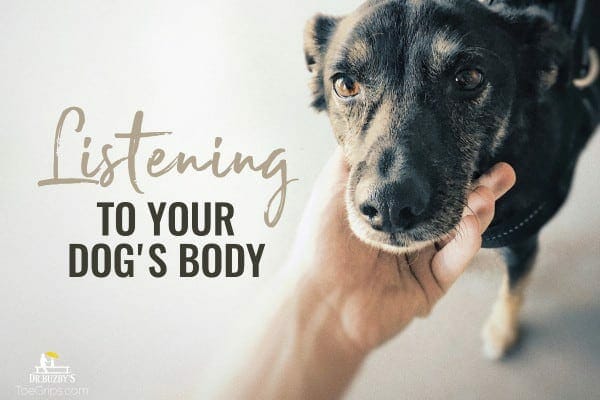
“Listening” to your dog’s body. It’s something that, consciously or subconsciously, you do every single day. Often dogs’ nonverbal cues are just as clear as if they were speaking English. An abnormal sign—a tilt of the head, a curve of the spine, a change in gait—may be associated with an underlying medical condition that needs addressed. Your dog may be trying to tell you that he or she is painful or uncomfortable and needs help.
One of the challenges of veterinary medicine is that my patients can’t share their complaints in their own words. Listening to my patient’s body—being perceptive, vigilant, and paying keen attention to body language and behaviors—is the hallmark of a great veterinarian. This is true for proactive pet parents too.
Certain postures and certain behaviors in dogs usually point to certain diagnoses. While this doesn’t hold true universally, I am reminded of something my professors in vet school would often quip:
“When you see horse hoofprints, don’t go looking for zebras.”
I know you want the absolute best for your dog—the longest, happiest, healthiest life. To that end, I think it’s worthwhile to share seven examples of “hoofprints” and how to listen to your dog’s body to look for the horses and know when to call your vet.

1. Lameness or limping in dogs
If your dog is favoring a leg, even slightly, I would classify that as lameness. The cause of an altered gait in dogs could be anything from a cut on the paw pad to a cervical disc issue. Then there are medical conditions with joints, tendons, ligaments, muscles, and nerves that can all cause lameness, too.
Here’s the point I want to make about lameness in dogs: I’m surprised at the very high percentage of my veterinary clients who point out a problem with their dog’s gait, and then say, “But I don’t think his leg hurts him.”
With good intentions and purity of heart, clients will tell me, “I don’t think my dog’s in pain, but he’s really not using his right front leg.”
Well, let’s clear that up right here and now. The dog IS in pain. If he weren’t in pain, he would be fully weight bearing on that leg. The reason he’s not fully bearing weight on the leg is because it hurts to do so. So, if your dog is limping but otherwise happy, I think it’s reasonable to wait a few minutes or hours to see if it resolves on its own. Just like us, dogs can experience transient soreness that will spontaneously resolve.
For example, a dog may be playing in the yard or jump off the couch and land “wrong” and then favor the leg for a little bit. But in these scenarios, very, very quickly, the dog will return to soundness (no limping). And that’s your “crystal ball” sign that it was nothing to worry about.
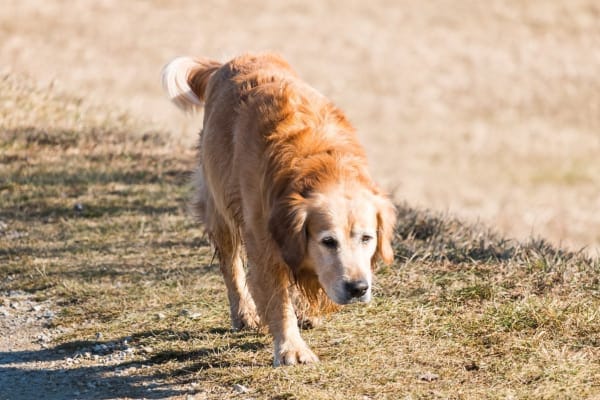
However, if your dog is favoring a leg without improvement for more than a brief period of time, that is something that needs to be evaluated by your veterinarian. Please call and schedule an appointment because I can promise you that your dog is hurting.
For a complete run down on limping and lameness in dogs, please check out my ultimate guide on why is my dog limping. For a brief overview, I’ve listed some common causes for dog limping or lameness below:
- Joint or muscle trauma
- Arthritis in dogs
- Fractures (broken bones)
- Dislocated joints such as luxating patella in dogs
- Torn ligaments
- Broken toenail (or dog ripped toenail off)
- Burn or injury to the paw or paw pad
- Stepping on a sharp object such as a piece of glass, thorn, or even getting an acorn stuck in the paw pad
- Neurologic conditions such as knuckling in dogs (a dog who is limping and curling his or her paw)
2. A hunched dog or a dog with an arched back
If you’re wondering, “Why is my dog hunching his back” it could be a sign of a more serious condition.
Picture this in your mind—a “roached” back or a hunched back in a dog, which looks more like a camel than a canine.

In a dog with a hunched back, the backbone, which creates posture and sets the topline (the profile line that extends from the withers to the base of the tail) becomes curved.
If this is a sudden onset problem—I’m talking about a dog who normally has a straight topline, and then one day doesn’t—two conditions come to mind:
Back pain
Back pain is one obvious concern if your dog’s back is arched. When a dog has a back problem, such as intervertebral disc disease (IVDD), often they’ll change the way that they carry themselves to guard their spine and minimize pain.
Back injuries can occur very suddenly in dogs. Just like when people throw out their backs, a dog can be fine one minute and in agony the next. It’s not always obvious what the issue may be. Dogs with back pain may simply have a hunched posture, they could be limping, they could be yelping when picked up or moving certain ways, etc. Dogs with severe back pain can also be more prone to snap at people or other dogs that come close to them.
Tummy pain
The less obvious worry is tummy pain. Gastrointestinal problems, pancreatitis in dogs, and stomach pain may all cause dogs to adjust their posture—either by hunching their back or sometimes preferring to get into a funny position which apparently relieves pain/pressure. It’s a version of the downward-facing dog yoga pose—the dog will have his haunches up in the back, but will go down to a praying position in the front.
Both back pain and visceral abdominal pain are typically very painful. An acute change of posture in your dog is a red flag to call your veterinarian.
3. A dog with a limp tail (dead tail)
Number three on the list is a strange one. It’s called dead tail. It’s also commonly referred to as cold tail, broken tail, limber tail, and swimmer’s tail.
Dead tail is a condition that I never heard mentioned in vet school. I learned about it through trial and error. Actually, just error. I missed the diagnosis early in my veterinary career and a senior colleague set me straight. Since then I’ve seen a dozen cases, including diagnosing my own dog.
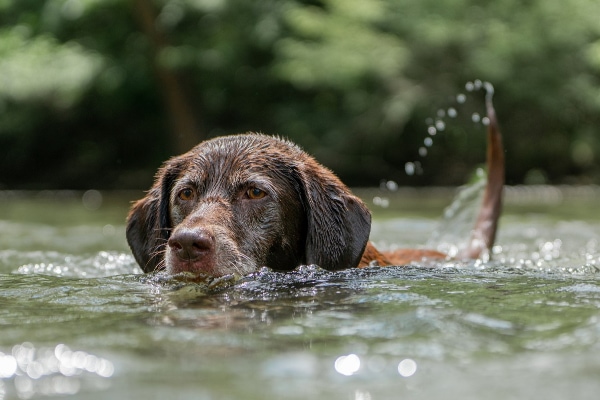
As the name suggests, a dog with this condition has a tail that just hangs limp. The dog may look perfectly normal until your eye reaches the base of the tail, and you recognize that something is just not right. The “set” of the tail extending from the body appears odd and there is no wagging happening. This is because movement is very painful.
I learned this the hard way. The only time my beloved rescue mutt, Jacobean, ever tried to bite me was when he presented with these symptoms, and I manipulated his tail during the examination to confirm the diagnosis.
Also, dead tail is often misdiagnosed. My sister’s dog is a prime example. She called me one morning in a panic and said, “Help! My dog has broken his tail. I think he wagged it too enthusiastically into our brass bed and now he can’t move it.”
This type of assumption by the dog parent is common because of the way dead tail presents, but I listened dubiously and asked a lot of questions. Indeed, “broken” tail was the diagnosis her veterinarian later made, but no fractures were involved!
Should you notice something wrong with your dog’s tail, contact your veterinarian. If dead tail is the diagnosis, the good news is that your dog should recover well with pain medications, anti-inflammatories, and supportive care. If you’re interested in learning more, please check out my podcast, Dead Tail in Dogs.
4. Neck pain in dogs
Cervical disc disease is one of the most painful conditions I see in practice, and it has one of the most distinctive postures. Cervical refers to the neck area and the discs are little “spacers” that sit between the vertebral bodies.
Neck pain in dogs due to a slipped disc is often excruciatingly painful. Movement hurts. And so, to guard against moving as a self-preservation mechanism, these dogs don’t really move their necks. They will hold their neck very still while tracking their surroundings exclusively with their eyes. They may even move their entire body to reposition so their eyes have a greater peripheral view.
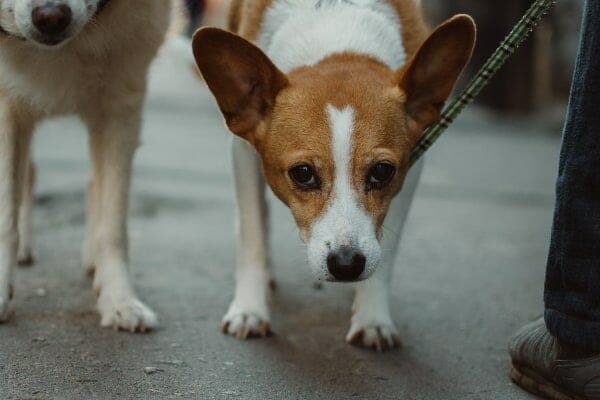
Sometimes the neck injury is more on one side than the other. In these cases, it can appear that the injured dog can’t move his or her head to one side. The dog may be fine moving his or her head to the right, for example, but will turn his or her entire body to look left.
If you take your hands and gently feel down the sides of the neck in a dog suffering from neck pain, typically one, if not both sides, will feel as hard as a rock due to muscle spasm.
This is a very serious condition. In a worst-case scenario, it can result in complete paralysis. But neurologic sequelae aside, just based on the degree of pain involved, if your dog is exhibiting signs of neck pain, please get to the veterinarian right away.
5. Ear pain in dogs
Have you ever had swimmer’s ear? My son had it while we were on vacation. His ear was so painful that we elected to go to the emergency room in a foreign country.
Ear issues in dogs can be similarly painful. If your dog has an ear problem, you may see one or more of the following signs or symptoms
- Pawing at the ear(s)
- Rubbing the ear(s) on the ground or on furniture
- Holding the ear(s) in a funny way
- Shaking the head (most common)
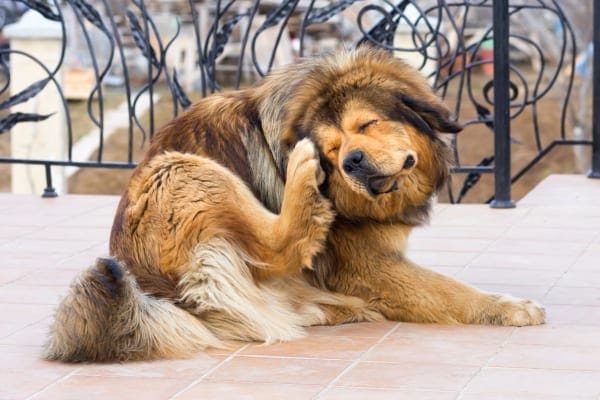
If you see any of these symptoms, here’s what I want you to do: gently retract the flap of the ear (called the pinna) and take a peek. Look for debris, discharge, and redness/inflammation.
Next, provided your dog is fully cooperative, it’s time for the sniff test. Put your nose up to the ear and take a big whiff. Unremarkable or funky? There should be no middle ground.
Finally, compare both ears. Sometimes dogs get bilateral ear infections, meaning both ears are affected. In this case, comparing them doesn’t really help because they’re both abnormal. But if only one side is affected, you can inspect both and often clearly see the difference between the good side and the bad side.
And once again, call your veterinarian, report your mini-exam findings, and get your dog seen because it hurts. And the faster you get treatment, the faster you’ll get it resolved.
6. A dog with a squinty eye (eye pain)
“Squinty eye” is the term I use when a dog is not holding the eye completely open. This is a symptom of eye pain, and it’s most commonly associated with a corneal ulcer.
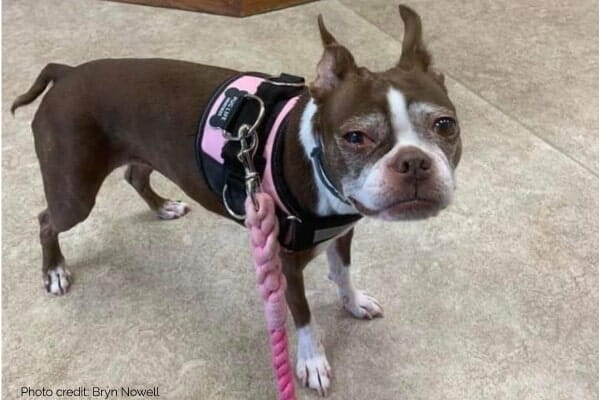
Photo credit: Bryn Nowell
During the stressful days of veterinary school, I developed a bad habit of grinding my teeth at night. I asked my dentist about it and she offered a solution. “Oh, no problem,” she said. “I’ll make you a mouth guard.”
Well, this was twenty-some years ago and she didn’t think to place protective eyewear on me while dremmeling down this plastic mouth guard near my face.
Next thing I know, a tiny piece shot off into my eye, and the pain was excruciating. The dentist was horrified. She canceled her appointments and personally drove me into the emergency ophthalmology doctor for treatment. He removed the offending particle, but my cornea had been scratched in the process. I was unable to hold my eye fully open because of the pain. I was squinting. Your dog will do the same if she or he has an eye issue.
My point is that the cornea has a plethora of nerve endings and it hurts a LOT when damaged. If your dog is squinting, seek veterinary care as soon as possible.
Eye issues in dogs can rapidly deteriorate and become emergencies fast. A squinty-eyed dog = a same day veterinary appointment!
7. A dog who is incessantly licking
Incessant licking is actually the most common manifestation of seasonal allergies in dogs. This includes licking at the paws or toes, or even biting or chewing at their paws. These dogs aren’t painful like the prior six examples, but they are miserable.
The good news is that there are a lot of helpful new medications available for treating allergies in dogs.

If you’ve had dogs in the past with allergies and you think, “Oh, you know, there’s really no options. My dog will either have to go on Benadryl for dogs, which doesn’t really help, or he will have to go on steroids, and deal with side effects! I’m just going to leave my dog alone and hope for better days to come when the weather changes.” I can assure you, that’s not the way it is anymore.
There are now some innovative, very specific medications in veterinary medicine that work really well and are much safer than steroids. I would encourage you to see your vet and talk about solutions if your dog has allergies (or if your dog is constantly licking or chewing at the paws).
But the paws are not the only “lick target” on dogs’ bodies. Here are just a few other places dogs may lick and why:
Dog licking joints
If a dog is licking over a joint consistently, that can indicate pain in that joint. Just like people might massage an aching joint, a dog might lick an injured or inflamed joint to provide some relief.
Excessive or repetitive licking of one area, particularly the wrist or top of the paw, may be a sign of a psychological, rather than physiological issue. Dogs who are stressed or bored can compulsively lick their paws or wrists, even to the point of causing skin irritation or lick granulomas over those areas.
If you notice your dog licking his or her joints, it’s time for a trip to the vet. He or she can help rule out any painful conditions, and provide your pup some relief.
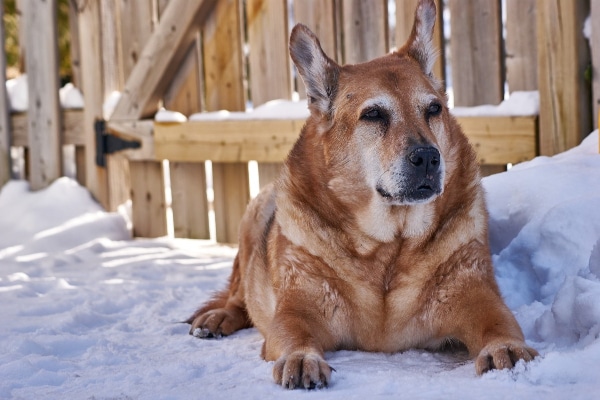
Female dog keeps licking her vulva
If a female dog is constantly licking her hind end around the vulva, that makes me wonder about a urinary tract infection or localized skin infection.
Typically, but not always, urinary tract infections in dogs cause a change in pee habits—generally peeing small amounts more frequently. If you notice a change in urination along with excessive licking, your vet will most likely be examining a urine sample to see if your dog needs a course of antibiotics.
Some female dogs have a recessed vulva. This means that the conformation of her hind end creates skin folds around her vulva. Moisture and bacteria get trapped in those folds and cause infections. The skin infections are very irritating and itchy.
Because dogs can’t reach to scratch their hind ends, they bite and lick. Licking an area that is already inflamed due to moisture just causes snowballing of the issue. The area is itchy, so she licks, which traps in more moisture, which causes inflammation, which is itchy…you see where this is going. In order to stop the problem, we have to break the cycle! Your vet can help.
For some dogs with recessed vulvas, medical management with antibiotics, medicated wipes, and a “cone of shame” can do the trick. For most of them, weight loss is a crucial part of the treatment plan.
Some dogs with more severe recessed vulvas, or ones for which medical management doesn’t work, may require surgery to remove excess skin.
Dog licking anus
If your dog won’t leave his bum alone, it may indicate a medical condition. Dogs who are licking around their anus are exhibiting a sign that they are uncomfortable.
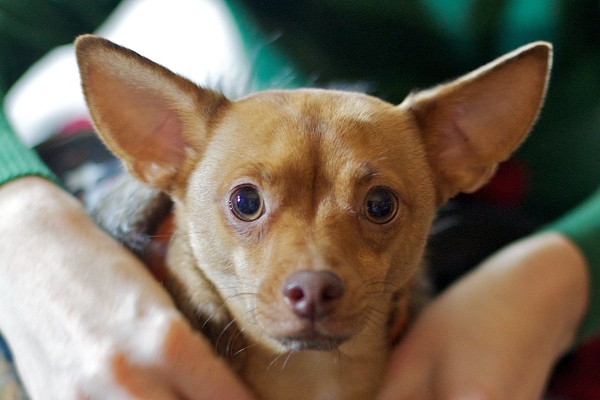
If you notice your dog licking his or her rear end, talk to your dog’s vet about potential causes.
Your dog may have full or impacted anal glands. Your vet will be able to examine and/or express these glands if needed. Please do not attempt to express your dog’s anal glands yourself—if not done correctly, this procedure can injure your dog!
Another possible cause of bum licking and/or scooting is intestinal parasites. Your vet can test your dog’s poop for worms and provide medication to help, if necessary.
Bottom licking can also be a sign of a food allergy. While you might think food allergies would cause GI discomfort, they actually typically cause itching in dogs! “Ears and rears” are usually problem areas in dogs with food allergies. If you think your dog may have a food allergy, talk to your vet about starting a diet trial to investigate.
Dog licking furniture, carpet, or rugs
Finally, some dogs that lick excessively aren’t even licking themselves. Dogs can become obsessed with licking the furniture or a rug. This may point to an upper gastrointestinal disease. Dogs with “heartburn” often lick objects around them.
Sometimes licking the floor or furniture can be a sort of compulsive behavior in dogs that are stressed, bored, or anxious. These dogs may need more exercise, enrichment, or maybe even behavioral medications.
All of these types of licking merit a veterinary visit because the dog’s not comfortable. A dog who is licking constantly is not the healthiest version of himself or herself!
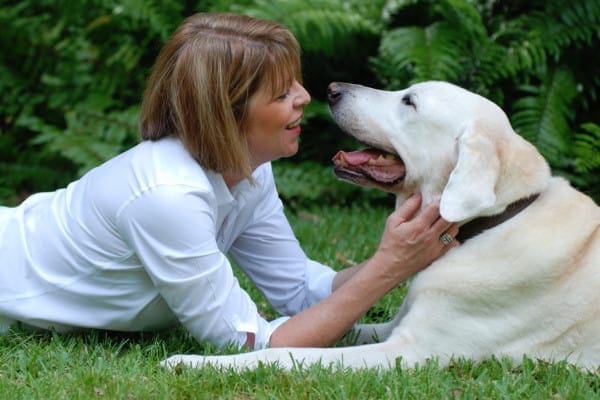
Giving your dog the best life possible
As you observe your dog’s body, it’s important to recognize that what is abnormal may be associated with a physical problem that must be addressed. Not only is resolving the problem important for the dog’s long-term health, but it may be painful or uncomfortable. None of us want our dogs to live with discomfort or pain.
A buzz phrase in modern wellness medicine is “listen to your body.” It’s good advice! I hope you listen to your body and your dog’s body too! We owe it to our “voiceless” pets to listen, be observant, and get them the care they need.


my senior dog seems depressed over the last few years. recently i acquired 2 female puppies. i thought that might chear her up. it backfired. she hardly ever comes out from under the house to socialize. it worse than ever with the new pups. she wont even go near their pen either. i feel terrible. she’s in her final days and my act has made her miserable. i cant just give the puppies to anybody but no one wants them. now she’s licked her left arm to redness. she’s limping on to legs and i just want to make her comfortable. damn!
Hi John,
I am so sorry you are dealing with this difficult and frustrating situation with your senior girl. Has she been to the vet for a checkup recently? There could be a medication or treatment that would help give her some relief and improve her quality of life. Of course, without examining your pup myself, I can’t make specific conclusions. But I am a bit suspicious that your girl may be showing signs of dementia/cognitive dysfunction. Here is a link to another article with more information: Canine Cognitive Dysfunction in Dogs: Signs, Symptoms, Solutions
I know you want to ensure your girl is happy and comfortable for the time she has left. Hoping you can partner with your vet to make that dream a reality. Wishing you both the best as you navigate this unknown path.
I have a senior (16 y/o) Chihuahua, Ace, and I have noticed some of these symptoms in him, especially “Squinty Eye” and then Bum licking in our senior (13y/o) Beagle-Dachshund, Scooby. I’m curious about a possible food allergy. i will definitely be getting the boys a vet appointment ASAP.
I really like this article. It’s very well written, you seem to be a “seasoned” vet who knows what they’re talking about, and you give multiple examples along with corresponding multiple explanations. These are great tips! Thank you so much for sharing these with us and for being a voice for our furbabies!!
Hi Abbey,
Thank you for the kind words and positive feedback about the article. Best wishes to you, Ace, and Scooby!
My husband and I HAD to make that HARD step.IT ALL HAPPENENED SO FAST AN IT WAS CLEAR TO US OUR SR. DOG WAS IN PAIN….TOOK A LOT OF COURAGE….
Jane, I’m so terribly sorry to hear this. Listening to our dog’s body is critically important with senior dogs and hard decisions. May God bless and comfort during this difficult time.
Great tips???
Thanks, Lisa! I appreciate your feedback!